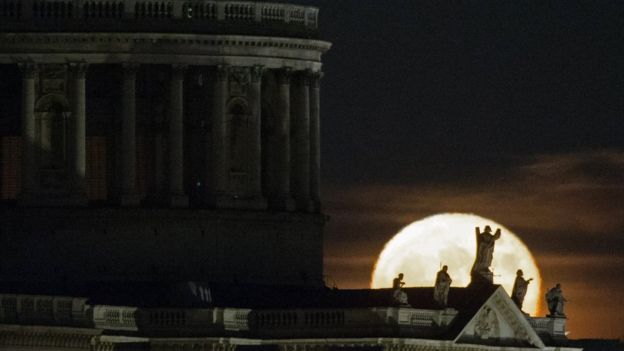A Supermoon will brighten up the skies on Sunday night in Pakistan in a phenomenon wherein the moon moves closer to the Earth.
Supermoon appears around 7% larger and 15% brighter, however, to the naked eye it would not appear much different. This one is the first and the last Supermoons of the year.
Two more Supermoons over the next two months will follow, on January 1 and 31 January, respectively.
A full moon arises when the Earth sits directly between the sun and the moon.
t will appear about 7% larger and 15% brighter, although the difference is barely noticeable to the human eye.
The exact moment of the full moon will be at 15:47 GMT.
Robert Massey, of the Royal Astronomical Society, said it will appear brightest at midnight – when at its highest point above the horizon.
The Met Office’s UK forecast suggests there will be clear spells this afternoon, so the supermoon may be visible.
Last year the Moon made its closest approach to Earth since 1948 – it won’t be that close again until 25 November 2034.
Nasa has called this weekend’s sighting the first in a “supermoon trilogy”over the next two months, with others to come on 1 January and 31 January.
December’s full moon is traditionally known as the cold moon.
This full moon on Sunday afternoon – when it sits opposite the sun in the sky – will be 222,761 miles from Earth, closer than its average 238,900 miles.
Moon illusion
Mr Massey says the “most spectacular views” will come during moonrise, on Sunday, and moonset, on Monday morning.
This is because an optical illusion, known as the Moon illusion, makes it look unusually large when it appears close to the horizon.
In the UK, the moonrise will start just after 16:00 GMT – in Edinburgh it will rise at 16:15; in London at 16:21 and in Cardiff at 16:33.
Mr Massey said: “It’s a nice enough phenomenon. It’s always nice for people to go out and look at it.
“You won’t necessarily think that it’s huge. It will appear a bit bigger than usual, but don’t expect it to look five times bigger.”
 Image copyrightAFP
Image copyrightAFPThe moon doesn’t move around Earth in a circle – it orbits in an elliptical or oval shape.
This means that its distance from Earth is not constant but varies across a full orbit.
But within this uneven orbit there are further variations caused by the Earth’s movements around the Sun.
These mean that the perigee – the closest approach – and full moon are not always in sync.
But occasions when the perigee and full moon coincide have become known as supermoons.





